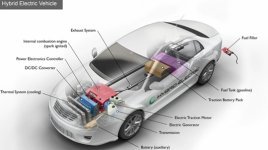tesla 1
Member
Choosing between an Electric Vehicle (EV), Plug-In Hybrid Electric Vehicle (PHEV), and Hybrid in 2024 depends on several factors like your driving habits, budget, environmental concerns, and access to charging infrastructure. Here’s a breakdown to help you decide:
1. Electric Vehicles (EVs):
Best for:
Environmental Impact: EVs produce zero tailpipe emissions, making them the best choice for reducing your carbon footprint.
Daily Commutes and Urban Driving: Ideal for those with short to medium daily commutes, especially if you have access to home charging.
Access to Charging: Suitable if you have reliable access to charging stations at home, work, or public spaces.
Lower Long-Term Costs: While the upfront cost can be higher, lower maintenance and fuel (electricity) costs can make EVs more economical over time.
Considerations:
Range Anxiety: Though many new EVs offer 250-300 miles per charge, long trips might require planning around charging stations.
Charging Infrastructure: Not ideal if you lack convenient access to charging, especially if you live in an apartment or a region with limited public charging.
Higher Upfront Cost: EVs typically have a higher initial purchase price, though tax incentives can offset this.
Examples in 2024:
Tesla Model 3/Y
Ford Mustang Mach-E
Hyundai Ioniq 5
Chevrolet Bolt EV
2. Plug-In Hybrid Electric Vehicles (PHEVs):
Best for:
Flexibility: Combines the benefits of electric driving with the convenience of a gasoline engine for extended range, ideal for both short commutes and long trips.
Mixed Driving Patterns: Ideal if you do a lot of city driving but still need the flexibility for longer trips without worrying about charging.
Lower Emissions: Offers reduced emissions compared to traditional hybrids when driven in electric mode, while still providing the backup of a gasoline engine.

Considerations:
Battery Size: Smaller than a full EV, so the electric-only range is usually between 20-50 miles, which might not cover all daily driving needs.
Higher Cost than Hybrids: Generally more expensive than standard hybrids, though often cheaper than full EVs.
Charging Required: To maximize benefits, regular charging is necessary; otherwise, you're just driving a heavier hybrid.
Examples in 2024:
Toyota RAV4 Prime
Ford Escape PHEV
Hyundai Tucson PHEV
Mitsubishi Outlander PHEV
3. Hybrids (Non-Plug-In):
Best for:
No Charging Required: Ideal if you’re not ready for the hassle of charging but still want improved fuel efficiency over a traditional gasoline car.
Lower Upfront Cost: Typically less expensive than EVs and PHEVs, making them more accessible.
Reliable Efficiency: Offers better fuel efficiency than conventional cars, especially in city driving, without the need for plugging in.
Considerations:
Less Environmental Impact: Hybrids still rely heavily on gasoline, so they’re less environmentally friendly than EVs or PHEVs.
No Electric-Only Driving: You can't drive on electricity alone, so while hybrids are efficient, they don't offer the same zero-emission benefits as EVs or PHEVs.
Examples in 2024:
Toyota Prius
Honda CR-V Hybrid
Ford Maverick Hybrid
Hyundai Elantra Hybrid
Which Should You Buy?
Buy an EV if: You prioritize environmental impact, have access to charging, and mainly drive within the vehicle's range. EVs are the best long-term investment in terms of running costs and future-proofing against stricter emissions regulations.
Buy a PHEV if: You want the flexibility of electric driving for daily commutes but need the convenience of a gasoline engine for longer trips. PHEVs are great for mixed-use scenarios and offer a good balance between reducing emissions and maintaining flexibility.
Buy a Hybrid if: You want better fuel efficiency without the need to charge and are looking for a lower-cost option compared to EVs and PHEVs. Hybrids are a great choice if you drive a lot and aren't ready to make the switch to electric just yet.
Conclusion:
The best option depends on your specific needs. EVs are the future, especially as charging infrastructure improves and ranges increase. PHEVs offer a great compromise, and hybrids provide a simpler, more affordable entry into more efficient driving. Evaluate your driving habits, budget, and environmental priorities to make the best choice for 2024.
Youtube
1. Electric Vehicles (EVs):
Best for:
Environmental Impact: EVs produce zero tailpipe emissions, making them the best choice for reducing your carbon footprint.
Daily Commutes and Urban Driving: Ideal for those with short to medium daily commutes, especially if you have access to home charging.
Access to Charging: Suitable if you have reliable access to charging stations at home, work, or public spaces.
Lower Long-Term Costs: While the upfront cost can be higher, lower maintenance and fuel (electricity) costs can make EVs more economical over time.
Considerations:
Range Anxiety: Though many new EVs offer 250-300 miles per charge, long trips might require planning around charging stations.
Charging Infrastructure: Not ideal if you lack convenient access to charging, especially if you live in an apartment or a region with limited public charging.
Higher Upfront Cost: EVs typically have a higher initial purchase price, though tax incentives can offset this.
Examples in 2024:
Tesla Model 3/Y
Ford Mustang Mach-E
Hyundai Ioniq 5
Chevrolet Bolt EV
2. Plug-In Hybrid Electric Vehicles (PHEVs):
Best for:
Flexibility: Combines the benefits of electric driving with the convenience of a gasoline engine for extended range, ideal for both short commutes and long trips.
Mixed Driving Patterns: Ideal if you do a lot of city driving but still need the flexibility for longer trips without worrying about charging.
Lower Emissions: Offers reduced emissions compared to traditional hybrids when driven in electric mode, while still providing the backup of a gasoline engine.

Considerations:
Battery Size: Smaller than a full EV, so the electric-only range is usually between 20-50 miles, which might not cover all daily driving needs.
Higher Cost than Hybrids: Generally more expensive than standard hybrids, though often cheaper than full EVs.
Charging Required: To maximize benefits, regular charging is necessary; otherwise, you're just driving a heavier hybrid.
Examples in 2024:
Toyota RAV4 Prime
Ford Escape PHEV
Hyundai Tucson PHEV
Mitsubishi Outlander PHEV
3. Hybrids (Non-Plug-In):
Best for:
No Charging Required: Ideal if you’re not ready for the hassle of charging but still want improved fuel efficiency over a traditional gasoline car.
Lower Upfront Cost: Typically less expensive than EVs and PHEVs, making them more accessible.
Reliable Efficiency: Offers better fuel efficiency than conventional cars, especially in city driving, without the need for plugging in.
Considerations:
Less Environmental Impact: Hybrids still rely heavily on gasoline, so they’re less environmentally friendly than EVs or PHEVs.
No Electric-Only Driving: You can't drive on electricity alone, so while hybrids are efficient, they don't offer the same zero-emission benefits as EVs or PHEVs.
Examples in 2024:
Toyota Prius
Honda CR-V Hybrid
Ford Maverick Hybrid
Hyundai Elantra Hybrid
Which Should You Buy?
Buy an EV if: You prioritize environmental impact, have access to charging, and mainly drive within the vehicle's range. EVs are the best long-term investment in terms of running costs and future-proofing against stricter emissions regulations.
Buy a PHEV if: You want the flexibility of electric driving for daily commutes but need the convenience of a gasoline engine for longer trips. PHEVs are great for mixed-use scenarios and offer a good balance between reducing emissions and maintaining flexibility.
Buy a Hybrid if: You want better fuel efficiency without the need to charge and are looking for a lower-cost option compared to EVs and PHEVs. Hybrids are a great choice if you drive a lot and aren't ready to make the switch to electric just yet.
Conclusion:
The best option depends on your specific needs. EVs are the future, especially as charging infrastructure improves and ranges increase. PHEVs offer a great compromise, and hybrids provide a simpler, more affordable entry into more efficient driving. Evaluate your driving habits, budget, and environmental priorities to make the best choice for 2024.
Youtube
